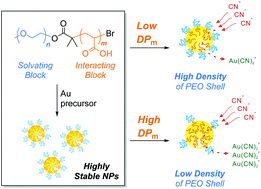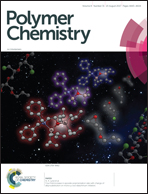Highly stable Au nanoparticles with double hydrophilic block copolymer templates: correlation between structure and stability†
Abstract
We herein report a facile synthetic method for preparing gold nanoparticles (Au NPs) with superior colloidal stability using a series of double hydrophilic block copolymers (DHBC), poly(ethylene oxide)-block-poly(acrylic acid) (PEO-b-PAA), as a template (Au@DHBC NPs). Due to the presence of a well-defined polymeric shell around the Au NPs, this DHBC-based synthetic method provides superior stability when compared to conventional citrate-based synthesis. We have investigated NP performance by systematically varying the molecular weight of the interacting PAA block from 5000 g mol−1 to 27 000 g mol−1. Interestingly, the size of the Au NPs did not significantly depend on the molecular weight of the PAA block and the density of DHBC present around a single NP decreased upon an increase in the molecular weight of the PAA block. Cyanide etching of Au@DHBC NPs further confirmed the presence of DHBC with different densities around the NPs, resulting in tunable stability. Considering the structural variability of DHBCs, it is expected that the approach presented in this study will offer a new means for creating Au NPs with enhanced colloidal stability for potential biological and biomedical applications.



 Please wait while we load your content...
Please wait while we load your content...